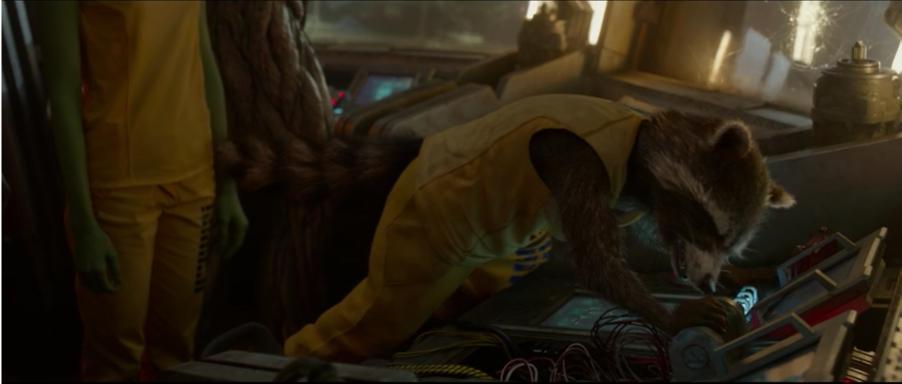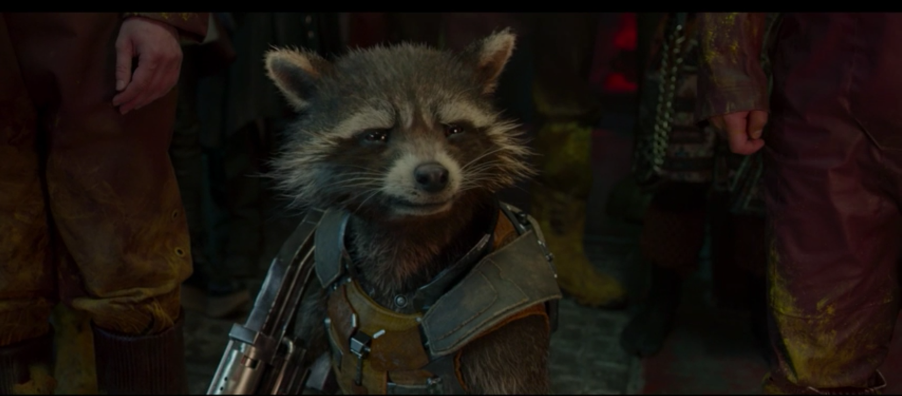Set in a parallel science- fiction universe, Guardians of the Galaxy[1] parodies Marvel’s usual ‘superhero’ film, by casting five criminal anti- heroes as the protagonists. The film follows five intergalactic – outlaw – anti- heroes as they are brought together by being arrested, over a bounty hunt on a mysterious orb. Previously individuals just working for themselves (with the exception of Rocket and Groot, who were already a team) Peter, Gamora, Drax, Rocket and Groot reluctantly decide to work together, to escape the prison, and then to split the ‘credits’ (money), for the orb, between them. Realising that the orb will be used for evil, however, we follow their journey as they go from petty criminals to (as you would expect, from the genre) saving the world. Simultaneously dramatic and comedic, with a fantastic 80s soundtrack, the film’s animal representation is more complicated than you might think. Violent and volatile, Rocket the Raccoon subverts the ‘small and cute’ anthropomorphised, animal standard. Alongside his best- friend Groot, Rocket makes anthropomorphism feel fresh and original.
Rocket the Raccoon is a sort of Jester- character. As an anthropomorphised Raccoon he is sub-human, diminutive and ‘other’. This ‘othering’, associated with his animality, means that he is able to get away with saying whatever, and being as blunt as, he likes. As an outsider, Rocket can comment on human society, without repercussion. In his opening dialogue, for instance, Rocket deconstructs and undermines society by saying: “Xanderians. What a bunch of losers. All of them in a big hurry to get from something stupid, to nothing at all. Pathetic”.

Rocket’s brutal, unapologetic, honesty continues throughout the film, following the conventions of a Jester character; uncovering the lies which subdue the world and denouncing shallow and aberrant institutions.[2] Animality used for Jester characters, in film, is nothing new. However, unlike Donkey from Shrek, [3] for instance, Rocket is confident, independent, tough and violent. Unlike the usual Jester character- type being non- threatening, with no chance of power, Rocket often threatens people, and takes control of situations. Rocket subverts the typical Jester character, whilst also subverting the typical ‘small and cute’ anthropomorphised, animal standard. He may be animalized and small, but he is definitely not cute, and he is definitely not opposed to guns and violence.
Rocket challenges the human/ animal binary by having both the characteristics of an animal, and the characteristics of a human. His personality is symbolically that of a Raccoon: highly intelligent and mischievous.[4] However, this intelligence is anthropomorphised; most significantly by the fact that he can talk. Significantly, Rocket rejects, or is oblivious to, being either ‘animal’ or ‘human’, asking “What’s a raccoon?” when Peter refers to him as one. This animality and anthropomorphism is juggled throughout the film, with him sometimes walking on two legs, sometimes on four, sometimes talking and sometimes growling. The human/ animal binary is further challenged by the fact that Rocket is more intelligent, in some ways, than the other protagonists, and is able to do things that the others cannot. When it comes to them escaping The Kyln (a high security prison) for instance, Rocket is in charge of the escape, having previously told the other characters that he has escaped 22 prisons. “We aint gonna be here long” he says, cockily, when they arrive at the prison: “I’ve escaped 22 prisons. This one’s no different”. The fact that Rocket actually does lead the escape from the prison suggests that there is something special, and unique, about the anthropomorphised, yet animalistic, intelligence that he has.

As an anthropomorphised character, with the appearance of an animal, however, Rocket is an outsider, in a world that sees him as ‘less than’ human. When the characters are arrested and brought together, at the start of the film, the authority/ police figures bring up all of the protagonists’ criminal documents. For Rocket, the guards say, as they read his document, “Calls itself Rocket. The result of illegal genetic and cybernetic experiment on a lower lifeform”.

Rocket is classed as a ‘lower lifeform’ and ‘it’ from the start, and this is echoed by the other protagonists calling him derogative names such as ‘rodent’ and ‘vermin’. At just over a third of the way through the film Rocket gets sick of this name calling and, when drunk, fights with Drax, before aiming a gun at him. “Keep calling me vermin, tough guy” Rocket says to Drax, whilst pointing a gun; “You just wanna laugh at me like everyone else”. Breaking up the fight, Peter says “Rocket, you’re drunk, alright. No one’s laughing at you”. Rocket, angry and sad, replies: “He thinks I’m some stupid thing, he does. Well I didn’t ask to get made. I didn’t ask to be torn apart and put back together over and over and turned into some, little monster”.

This speech is a really significant part of the film, making the other characters reflect on the language they have used towards Rocket, and challenging the anthropocentric view of animals as ‘lesser than’. Previously acting like nothing bothers him, his emotions are exposed in this scene and, despite his aggressive drunkenness, the viewer cannot help but feel for him. It is interesting that Rocket’s anthropomorphised character is explained as being as a result of ‘illegal genetic and cybernetic experiment’. Whereas anthropomorphised animals in film are usually actively trying to be human (such as Remy the Rat, in Ratatouille[5]) or passively anthropomorphised (just so happen to talk/ walk on two legs, like the majority of anthropomorphised animals in film), Guardians of the Galaxy approaches anthropomorphism differently. In Guardians of the Galaxy, Rocket’s backstory is that he was unwillingly genetically and cybernetically altered. Therefore, his anthropomorphism is as a result of violence. This subverts the anthropocentric idea that humans are superior to animals, and that animals would, if they could, be humans. Furthermore, Rocket’s backstory, although science-fictionised, seems to refer to, and expose, the treatment of a lot of animals in animal testing facilities, with it being estimated that more than 100 million animals are used in experiments each year across the world.[6]
Rocket’s character is most significant in relation to his partner in crime, Groot. Their relationship is an important aspect of animal representation in the film. Described as a “humanoid plant”, Groot is also an anthropomorphised character; walking on two legs, with a human-like face and human facial expressions. However, Groot can also be seen as animalised, and a representation of animality, with his limited dialogue of “I am Groot” (the only thing that he can say). Groot, therefore, could represent any animal: from a cow’s ‘moo’ or a cat’s ‘meow’, Groot’s ‘I am Groot’ represents the limited sounds/ vocabulary of animals. Symbolically, however, Groot represents nature. A tree like creature, Groot is made up of roots that he can instantly extend and grow more of. He can also create plants and light, instantly from his body.

Groot as symbolic for nature is most obvious near the end of the film, when Groot sacrifices himself to save the other hero’s lives. On a spaceship, about to crash land, Groot grows roots and branches into the shape of a globe, around the other characters, to shield them from the impact of the crash. James Gunn, the director, deliberately uses the shape of a globe to symbolically link Groot to nature, and to the planet.

What has this got to do with animal representation, you may ask? Well, it is significant that the only character that understands Groot, and truly loves and cares about him, is Rocket. Although the other characters end up appreciating Groot, and are amazed by his abilities, they still do not completely connect with him, on a deep level, like Rocket does. The representation of animals in Guardians of the Galaxy, therefore, shows animals as being more connected with nature, than humans are. Through Rocket and Groot’s relationship, the film challenges an anthropocentric attitude towards nature and animals. Nature and animals are shown to be more important, than the humans, in the film, with their relationship presented as something humans ought to aspire to.
In conclusion, Rocket’s anthropomorphised character, and the animal representation in Guardians of the Galaxy, is fresh and original. Rocket subverts the anthropomorphic and diminutive animal characters that are usually on our screen, whilst also challenging the anthropocentric view of, and approach to, animals as ‘less than human’/ ‘vermin’. Furthermore, although funny and light-hearted, the film presents profound symbolism. Rocket and Groot symbolise the harmony between, and the significance of, animals and nature. This completely challenges the anthropocentric view of human superiority.

References:
[1] Guardians of the Galaxy, dir. by. James Gunn (Walt Disney Studios Motion Pictures, 2014)
[2] Paolo Santarcangeli, ‘The Jester and the Madman, Heralds of Liberty and Truth’, Diogenes, 27.106 (1979), 28-40 <http://dx.doi.org/10.1177/039219217902710602> (pp. 37)
[3] Shrek, dir. by. Andrew Adamson and Vicky Jenson (DreamWorks Pictures, 2001)
[4] One Kind Planet, ‘Animal A-Z: Raccoon’, One Kind Planet, <https://onekindplanet.org/animal/raccoon/> [accessed 30 May 2020]
[5] Ratatouille, dir. by. Brad Bird and Jan Pinkava (Buena Vista Pictures Distribution, 2007)
[6] RSPCA, ‘Advice and welfare: Laboratory animals’, RSPCA, <https://www.rspca.org.uk/adviceandwelfare/laboratory> [accessed 30 May 2020]
Bibliography:
Adamson, Andrew and Vicky Jenson, dir., Shrek (DreamWorks Pictures, 2001)
Bird, Brad and Jan Pinkava, dir., Ratatouille (Buena Vista Pictures Distribution, 2007)
Gunn, James, dir., Guardians of the Galaxy (Walt Disney Studios Motion Pictures, 2014)
One Kind Planet, ‘Animal A-Z: Raccoon’, One Kind Planet, <https://onekindplanet.org/animal/raccoon/> [accessed 30 May 2020]
RSPCA, ‘Advice and welfare: Laboratory animals’, RSPCA, <https://www.rspca.org.uk/adviceandwelfare/laboratory> [accessed 30 May 2020]
Santarcangeli, Paolo, ‘The Jester and the Madman, Heralds of Liberty and Truth’, Diogenes, 27.106 (1979), 28-40 <http://dx.doi.org/10.1177/039219217902710602>
Further Reading:
Bradshaw, Peter, ‘Guardians of the Galaxy review – smart and funny retro thrills’, The Guardian, 2014 <https://www.theguardian.com/film/2014/jul/31/guardians-of-the-galaxy-review-marvel-superheroes>
Burt, Jonathan., ‘The Illumination of the Animal Kingdom: The Role of Light and Electricity in Animal Representation’, Society & Animals, 9.3 (2001), 203-28 <http://dx.doi.org/10.1163/156853001753644381>
Weisskircher, Manès., ‘New Technologies as a Neglected Social Movement Outcome: The Case of Activism against Animal Experimentation’, Sociological Perspectives, 62.1 (2019), 59-76 <http://dx.doi.org/10.1177/0731121418788339>
Wells, Paul. The Animated Bestiary: Animals, Cartoons, and Culture (New Brunswick, New Jersey: Rutgers University Press, 2008). ProQuest Ebook Central.